The fires came from the north. Even the future king of Norway took part in the war that was to determine the fate of the Piast state. "The law of war was not easy for the Lechites" - noted in Scandinavian songs. And it couldn't be more apt.
It was summer 1030 and black, storm clouds were gathering over the head of the Polish king Mieszko. Successive intelligence agents brought more and more disturbing news. The ruler of Germany, Konrad, summoned almost inexhaustible troops of knights to arms. At the same time, the Russian prince Jarosław Mądry was also getting ready to fight. The vision of the first partition of Poland - conceived by the jealous brothers Mieszko, Bezprym and Otto - was soon to be turned into reality.
Mieszko's first mistakes
Threats were looked for in two parts of the country, separated by almost eight hundred kilometers. Mieszko did not have enough strength to successfully defend both borders. He could not count on the fact that, after dealing with one of the opponents, he would be able to transfer his forces to the opposite front. Even on horseback and in a hurry, soldiers would need at least two weeks to cover the distance between the fighting episodes. Difficult decisions had to be made.
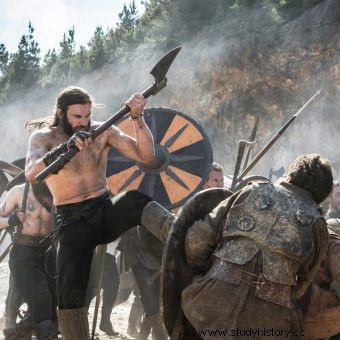
The Vikings were attacking Poland just like Rollo was attacking France. Still from the "Vikings" series.
Mieszko was at a loss. He lacked good advisers, and he had just dismissed his politically proficient wife, placing the concubine higher than her. Finally, he decided that Konrad was the greater threat. He surrounded the western border with his troops, leaving only symbolic forces behind the Bug. The soldiers were hungry to fight. Weeks passed, however, and they were still idle at their post. Finally the news came that they had lost. And without firing a single bow shot.
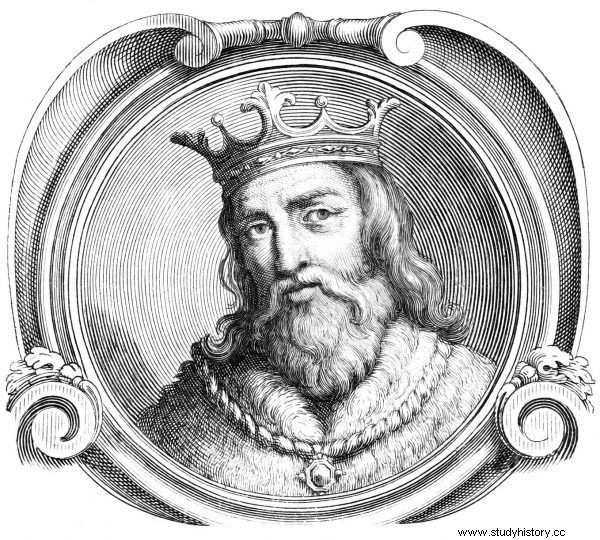
Mieszko II put the fate of the state on one card. Unfortunately, the wrong ... (source:public domain).
Konrad changed his plans at the last moment. Exactly at the time when he was concentrating his armies, there was a sudden escalation of the conflict on the German-Hungarian border. The Magyar king, Stefan, had for several years been making absurd claims against all of Bavaria. He claimed that he deserved the German principality because he had married the sister of the late Emperor Henry. Finally, he moved from words to deeds. The border was on fire. And Konrad apparently came to the conclusion that Hungarians deserve his attention more than Poles.
He led the already gathered armies to the Pannonian Basin instead of Greater Poland. However, Mieszko did not even have time to breathe a sigh of relief. While his warriors were keeping watch in the west, waiting for the enemy, who had melted like a nightmare, Jarosław attacked the Polish Belz. He took the town and the entire region under his control almost without a fight.
The Polish king undoubtedly made a desperate attempt to save the situation. However, when he and the team broke through the whole country, it was simply too late for the contract. The Russians had manned Polish fortresses long ago and now openly mocked the Piast warriors.
Against Poland, the Braves and the Vikings
The mood in Mieszko's army was gloomy. Meanwhile, Jarosław's warriors were about to fight another fight. The incidents of 1030 could be considered a failure of the pact made by Bezprym. After all, there was no planned, two-sided attack on Poland. But you could also turn a blind eye to the difficulties and assume that it was just a dress rehearsal. And this rehearsal was received by the audience with a real storm of applause ...
Another year has passed and the Polish king would be ready to swear that he is troubled by the worst possible case of déjà vu. The situation repeated itself to the letter. Konrad once again stood just outside the Polish border. The Russians were concentrating their armies again ... If anything changed, then the scale of the problems was.
Jarosław was so fond of war that he made an alliance with his greatest enemy - brother Mścisław, with whom he had until recently fought difficult battles for power over Ruthenia. Now Mścisław - bearing, by nomen omen, the nickname Chrobry - has agreed to join the invasion of Poland. There were also hundreds of Viking soldiers in the Ruthenian ranks. The greatest adventurers and most dangerous warriors of this era.
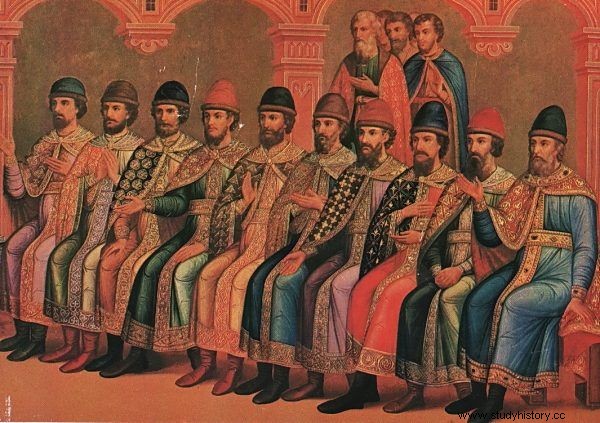
As can be seen in the picture above, Włodzimierz the Great had many sons. Two of them played a special role in the events of 1031 - not only Jarosław the Mądry, but also Mścisław the Brave. Fragment of a fresco from the Kremlin Graniasta Chamber at the turn of 1881/82 (source:public domain).
A country troubled
Mieszko felt that the throne was burning beneath him. And the reluctant murmurs of warriors who doubted his talents did not make the situation any better. He was still struggling, looking for a way out of the snare. Encircling only one border with a strong army did not help. So this time he divided his forces. And not in two, but probably even three parts.
Jarosław's spectacular success also emboldened other enemies of Poland. Threatening hoots came mainly from Prague. And Mieszko could not be sure that sometimes the ruling Ołdrzych Przemyślida would not decide to join the fight, when the Germans and the Ruthenians had already taken the Piasts in their clamps.
The fighting could take place almost anywhere on the border stretching for hundreds of kilometers. Mieszko staked each of the potential trouble spots. To this end, he was forced to strip the garrisons of the entire center of the country. It didn't help much either. His troops weren't really threatening anywhere. And nowhere did they hope to successfully receive a general strike.
Mieszko on the retreat
On September 16, 1031, Konrad, in the lead of the army, left Belgern on the Elbe. He pulled towards Bautzen and it seems ... he took it without a fight. Mieszko's forces avoided confrontation. No great battle is mentioned in the annals and chronicles. Apparently, there were only symbolic skirmishes. The Poles retreated as far as the borders of Silesia, exposing to the Germans all the lands for which Bolesław the Brave had fought for two decades. All of Milsko and Lusatia. And it wasn't a trick at all.
Mieszko did not plan to deceive the enemy, hoping that he would tire of the long march, and that disease and desertions would exhaust his strength. He simply didn't have time for this. Two weeks passed and the Polish king asked for peace. He hoped he could disarm the crisis before it entered its decisive phase. So:before the Russians come in. The ruler of Kiev had already been burned by the alliance with Germany once, and on this occasion he was clearly delaying the launch of the attack. Just like Stalin. Also in September, but in 1939.
Mieszko was ready to make any concessions. He agreed to return each of his father's gains, exposing himself to the wrath of the old guard. He also agreed to give up all the loot taken from Saxony a few years earlier, despite the fact that this condition threatened the rebellion of younger members of the team. People who made fortunes thanks to the cursed expedition to the German border.
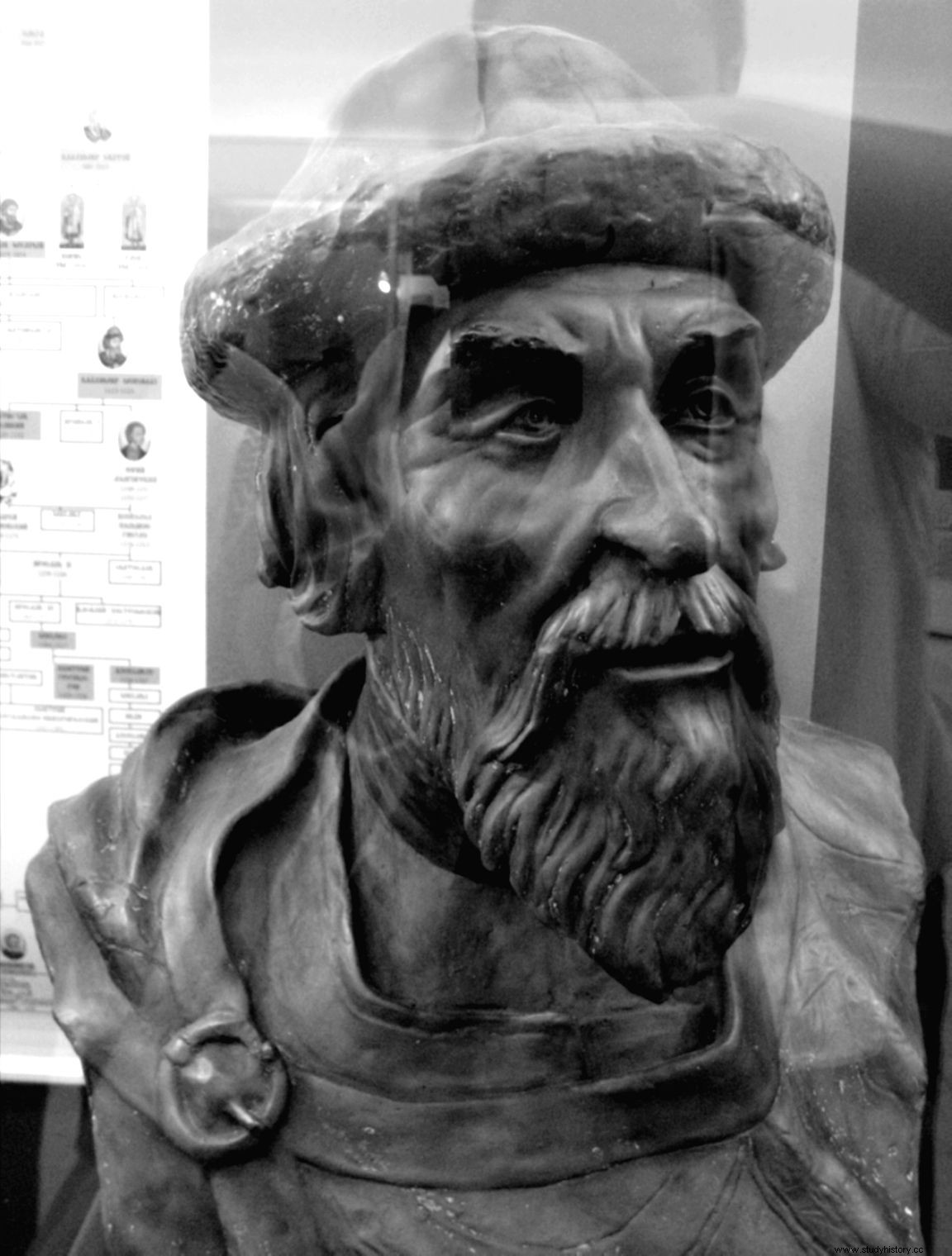
Jarosław Mądry was clearly delaying the start of hostilities, waiting for the German movement. Just like Joseph Stalin did 900 years later. The photo shows the reconstruction of the Grand Duke's face, made in 1939 (!) By the anthropologist Mikhail Gerasimov (photo:Shakko, license CC BY-SA 3.0).
It took only a few days of negotiation for the king's reputation to be completely tarnished. Mieszko knew how hard the battles with internal opposition awaited him now. But he was willing to face her if it meant saving the throne. His hopes were never fulfilled. As soon as the emperor returned to his country, the invasion began from the east.
The Last Great Viking
Jarosław's forces entered Poland like butter. The prince of Kiev had thousands of soldiers on his side. Even the future king of Norway fought in his ranks. A brawler by the name of Harald, who in the following years would become famous as the commander of the Varesian armies of Constantinople. The authors of the sagas will celebrate his military successes in the fighting over the Black Sea, Sicily, and Asia Minor.
If the legends are to be believed, Harald will even venture into the Holy Land. Finally, with enormous treasures, he will return to Scandinavia and sit on the throne as one of the most harsh and ruthless rulers of this era. His descendants will refer to him as the "Lightning of the North". Historians, on the other hand, are the last of the great Viking kings. Or even:the last great Viking.
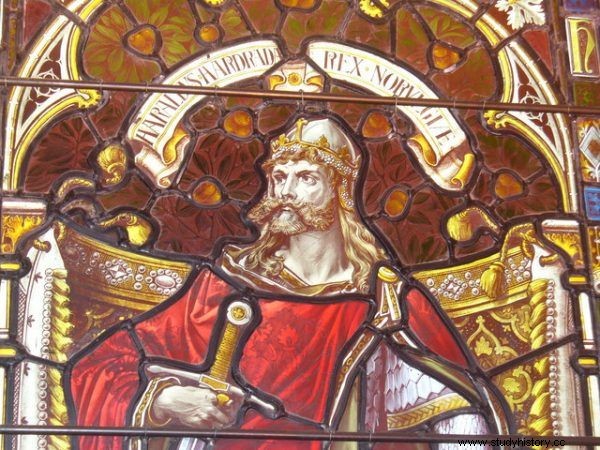
Even in the stained glass of Kirkwall Cathedral, Harald Hardrada looks stern. No wonder that he deserved to be called the last great Viking (photo by Colin Smith, license CC BY-SA 2.0).
Before Harald Hardrada achieved all this, as a youngster he fought with Poles. He fought together with another swashbuckler from the North, Eilif. Years later, the anonymous bard recalled:“The two chiefs, where Eilif, there are Harald, together formed a tusk of combat. The Eastern Wends were caught in ticks ”. And at the end of the short poem, he added a very significant summary:"the law of war was not easy for the Lechites."
Troops thirsty for blood and loot of the Vikings easily broke through the resistance of the border garrisons. Then, there was simply no one to defend himself. The gates were empty, the gates were empty of guards. It was no longer a war, but a triumphant march. Their former courtiers, servants and soldiers joined Bezprym and Otto. There were also deserters, who doubted Mieszko's fitness to rule.
The offensive started in mid-October. Not even a month had passed and Bezprym was already near Poznań. Mieszko tried to bind the enemy's forces, but the burly Vikings were pushing the remnants of his army farther south. He was unable to withdraw to Hungary - the Rus' blocked his way. He was forced to cross the border with the Czech Republic. And he was counting on the old Alder, who had recently been clearly at odds with the Emperor Conrad, to show him at least a little forbearance.
Selected bibliography:
- J. Banaszkiewicz, "Lestek" (Lesir) and "Lechici" (Lesar) in the medieval Scandinavian tradition, "Kwartalnik Historyczny", vol. 108 (2001).
- J. Bieniak, Polish political elite of the 12th century, "Society of Medieval Poland", vol. 10 (2004).
- D. Borawska, The crisis of the early Piast monarchy in the 1330s , Warsaw 2013.
- P. Grierson, Harold Hardrada and Byzantine Coin Types in Denmark, "Byzantinische Forschungen", vol. 1 (1966).
- T. Grudziński, Comments on the genesis of the revolution in Poland under Kazimierz the Restorer, "Notes of the Scientific Society in Toruń", vol. 18 (1953).
- G. Labuda, Mieszko II, King of Poland (1025–1034). Times of breakthrough in the history of the Polish state , Poznań 2008.
- G. Labuda, The loss of Moravia by the Polish state in the 11th century, [in:] Studies in Polish and Czechoslovakian History, vol. I, ed. E. Maleczyńska, K. Maleczyński, Wrocław 1960.
- M. Matla-Kozłowska, The First Przemyślids and their country (from the 10th to the mid-11th century), Poznań 2008.
- A. Pospieszyńska, Mieszko II and Germany , "Annals of History", vol. 14 (1938).
- J.D. Richards, Viking Age England, London 2004.
- J. Sochacki, Public-law relations between the Polish state and the Roman Empire in the years 963–1102, Słupsk – Gdańsk 2003.
- B. Śliwiński, Bezprym. Firstborn son of the first king of Poland (986 – winter / spring 1032) , Krakow 2014.
